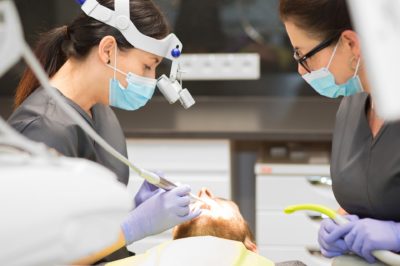Our specialists:

Agnieszka Witek
ASSISTANTHYGIENIST

Natalia Bartusiak
ASSISTANT
Regular and professional prophylaxis carried out by hygienists, consisting of scaling, sandblasting deposits and polishing the teeth, will allow you to keep a healthy and beautiful smile for longer, protecting against caries and periodontal diseases. Oral hygiene is safe, painless and effective – preventive treatments significantly reduce the risk of developing oral cavity diseases. It is also an important element of taking care of the aesthetics of a smile – the removal of tartar and deposits is the basis for improving the appearance of the teeth.
What is dental hygiene?
You should take care of oral hygiene everyday – brushing your teeth, flossing the interdental spaces and rinsing the mouth with a dedicated antibacterial fluid. In this way, the accumulation of tartar, which is responsible for the development of certain dental and periodontal diseases, is prevented. The patient’s diet is also important – the less simple carbohydrates (which are a breeding ground for bacteria living in the mouth, e.g. sugars) in the daily menu, the better.
Incomplete cleaning may result in a build-up of limescale which can only be removed with preventive measures. The basic oral hygiene treatment is scaling, which is used to remove plaque from the tooth surface and also from under the gum surface. Its regular performance is the basis for caring for the condition of the oral cavity. Sandblasting is the next stage that perfectly complements scaling – its performance is used to remove the remains of hard-to-reach deposits and some discoloration from the surface of the teeth.
The penultimate stage of hygienization is polishing, i.e. polishing. Thanks to it, the teeth become smooth, which slows down the process of tartar deposition. Finally, tooth fluoridation is carried out, which strengthens the tooth structure and reduces its susceptibility to harmful acids and bacteria responsible for the development of caries.
It is worth experiencing these treatments’ effects to feel the benefits. We recommend the above-mentioned treatments to people who consume large amounts of sugar and sweetened products, and drink a lot of coffee and tea. Oral hygienisation is also an important element of aesthetic dentistry – the removal of tartar and deposits from the surface of the teeth improves the effectiveness of the whitening treatment.
Does sandblasting whiten my teeth?
Whether or not sandblasting whitens teeth is interpreted differently. The fact is that the procedure has a positive effect on the aesthetics of the teeth – removing deposits and some discolorations may make them look brighter – but it does not brighten the enamel. For this reason, in the case of sandblasting, there is no whitening effect.
Does scaling hurt?
Patients ask – “does scaling hurt?”. The sensations during tartar removal depend on the patient’s sensitivity – most often the discomfort resulting from the procedure is far from pain. After scaling, a slight tooth sensitivity may persist for some time (in most cases no longer than two hours), which can be alleviated by using appropriate toothpastes and rinses.
How long does oral hygiene take?
Performing oral hygiene requires a maximum of thirty minutes – during this time, scaling, sandblasting, fluoridation and tooth polishing treatments are performed. Everything is carried out during one dental visit. About two or three hours after the procedure, the patient should refrain from eating and drinking (except mineral water).
How much does hygienisation cost?
The cost of oral hygiene depends on the type of procedures performed and the build-up of tartar. Preventive treatments are always cheaper and less stressful than the treatment of lesions. We recommend cyclical scaling, sandblasting and varnishing – preferably once every six months.
